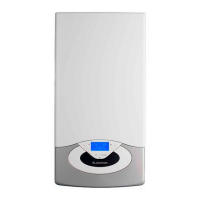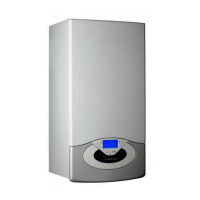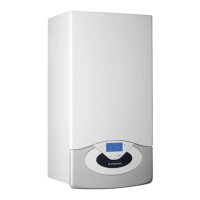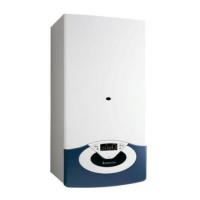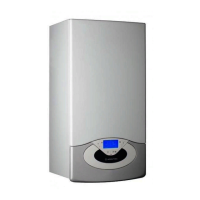43
manutenzione maintenance
La manutenzione è essenziale per la sicurezza, il buon funzionamento
e la durata della caldaia. Va e ettuata in base a quanto previsto dalle
norme vigenti.
E’ consigliabile eseguire periodicamente l’analisi della combustione
per controllare il rendimento e le emissioni inquinanti della caldaia,
secondo le norme vigenti.
Prima di iniziare le operazioni di manutenzione:
- togliere l’alimentazione elettrica posizionando l’interruttore
bipolare esterno alla caldaia in posizione OFF;
- chiudere il rubinetto del gas e dell’acqua degli impianti termici e
sanitari.
Al termine vanno ripristinate le regolazioni iniziali.
Note Generali
Si raccomanda di e ettuare sull’apparecchio, almeno una volta
l’anno, i seguenti controlli:
1. Controllo delle tenute della parte acqua con eventuale sostituzione
delle guarnizioni e ripristino della tenuta.
2. Controllo delle tenute della parte gas con eventuale sostituzione
delle guarnizioni e ripristino della tenuta.
3. Controllo visivo dello stato complessivo dell’apparecchio.
4. Controllo visivo della combustione ed eventuale smontaggio e
pulizia del bruciatore
5. A seguito del controllo al punto “3”, eventuale smontaggio e
pulizia della camera di combustione.
6. A seguito del controllo al punto “4”, eventuale smontaggio e
pulizia del bruciatore e dell’iniettore.
7. Pulizia dello scambiatore di calore primario.
8. Veri ca del funzionamento dei sistemi di sicurezza riscaldamento:
- sicurezza temperatura limite.
9. Veri ca del funzionamento dei sistemi di sicurezza parte gas:
- sicurezza mancanza gas o amma (ionizzazione).
10.Controllo dell’e cienza della produzione di acqua sanitaria
(veri ca della portata e della temperatura).
11.Controllo generale del funzionamento dell’apparecchio.
12.Rimozione dell’ossido dall’elettrodo di rilevazione tramite tela
smeriglio.
Prova di funzionamento
Dopo aver e ettuato le operazioni di manutenzione, riempire il
circuito di riscaldamento alla pressione di circa 1,0 bar e s atare
l’impianto.
Riempire anche l’impianto sanitario.
- Mettere in funzione l’apparecchio.
- Se è necessario s atare nuovamente l’impianto di riscaldamento.
- Veri care le impostazioni e il buon funzionamento di tutti gli
organi di comando, regolazione e controllo.
- Veri care la tenuta e il buon funzionamento dell’impianto di
evecuazione fumi/prelievo aria comburente.
Operazioni di svuotamento
Lo svuotamento dell’impianto di riscaldamento deve essere eseguito
nel seguente modo:
- spegnere la caldaia e portare l’interruttore bipolare esterno in
posizione OFF e chiudere il rubinetto del gas;
- allentare la valvola automatica di sfogo aria;
- aprire il rubinetto di scarico dell’impianto raccogliendo in un
contenitore l’acqua che fuoriesce;
- svuotare dai punti più bassi dell’impianto (dove previsti).
Se si prevede di tenere l’impianto fermo nelle zone dove la temperatura
ambiente può scendere nel periodo invernale al di sotto di 0°C, si
consiglia di aggiungere liquido antigelo all’acqua dell’impianto di
riscaldamento per evitare ripetuti svuotamenti; in caso di impiego
di tale liquido, veri carne attentamente la compatibilità con l’acciaio
Maintenance is an essential part of the safe and e cient operation of
the boiler and ensures its durability. It should be performed according
to the instructions given in current legislation. Perform combustion
analysis regularly in order to check the operating e ciency of the
boiler and to make sure any polluting substances released are within
the boudaries set by current legislation.
Before beginning maintenance work:
- Disconnect the appliance from the electricity supply by turning
the external bipolar switch to the “OFF” position;
- Close the gas valve and the central heating and domestic hot
water system valves.
After the work has been completed the initial settings will be restored.
General comments
It is recommended that the following inspections be carried out on
the boiler at least once a year:
1. Check the seals in the water part and, if necessary, replace the
gaskets and restore the seal to perfect working order.
2. Check the seals in the gas part and, if necessary, replace the
gaskets and restore the seal to perfect working order.
3. Visually check the overall condition of the boiler.
4. Visually check the combustion and, if necessary, disassemble
and clean the burner.
5. Following the inspection detailed in point “3”, disassemble and
clean the combustion chamber, if necessary.
6. Following the inspection detailed in point “4”, disassemble and
clean the burner and injector, if necessary.
7. Cleaning the primary heat exchanger
8. Make sure the following heating safety devices are operating
correctly:
- temperature limit safety device.
9. Make sure that the following gas part safety devices are
operating correctly:
- absence of gas or ame safety device (ionisation).
10. Check the e ciency of the domestic hot water production
process (test the ow rate and temperature).
11. Perform a general inspection of the boiler operation.
12. Remove oxide from the detection electrode using an emery
cloth.
Operational test
After having carried out the maintenance operations, ll the heating
circuit at a pressure of approximately 1.5 bar and release the air from
the system.
Fill the domestic hot water system at the same time.
- Begin operating the boiler.
- If necessary, release the air from the heating system again.
- Check the settings and make sure all the command, adjustment
and monitoring parts are working correctly.
- Check the ue system is sealed and operating correctly.
Draining procedures
The heating system must be drained using the following procedure:
- Switch o the boiler, make sure the external bipolar switch is in the
OFF position and shut o the gas valve;
- Loosen the automatic air relief valve;
- Open the system drain o cock and collect the escaping water in a
container;
- Empty the water from the lowest points of the system (where
applicable).
If the system is to be left inactive in areas where the room temperature
may fall below 0°C during winter, we recommend that anti-freeze
liquid is added to the water in the heating system in order to avoid
the need for repeated draining; when this liquid is used make sure it

